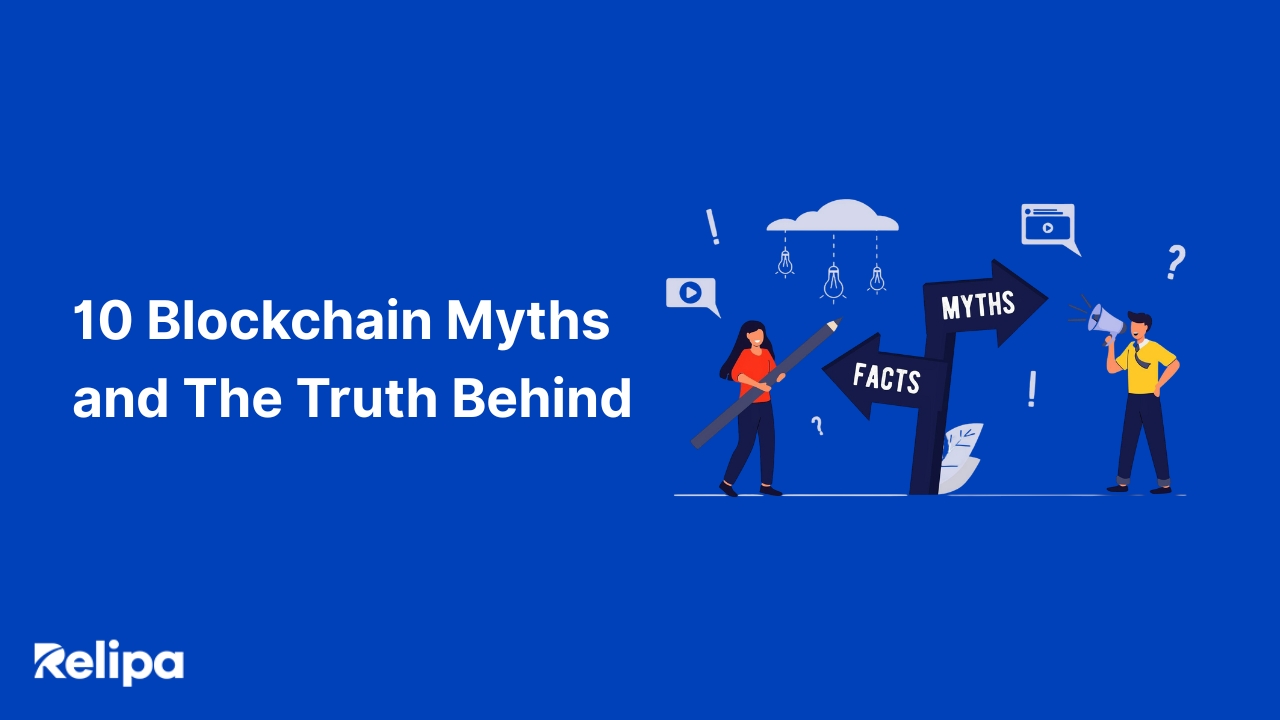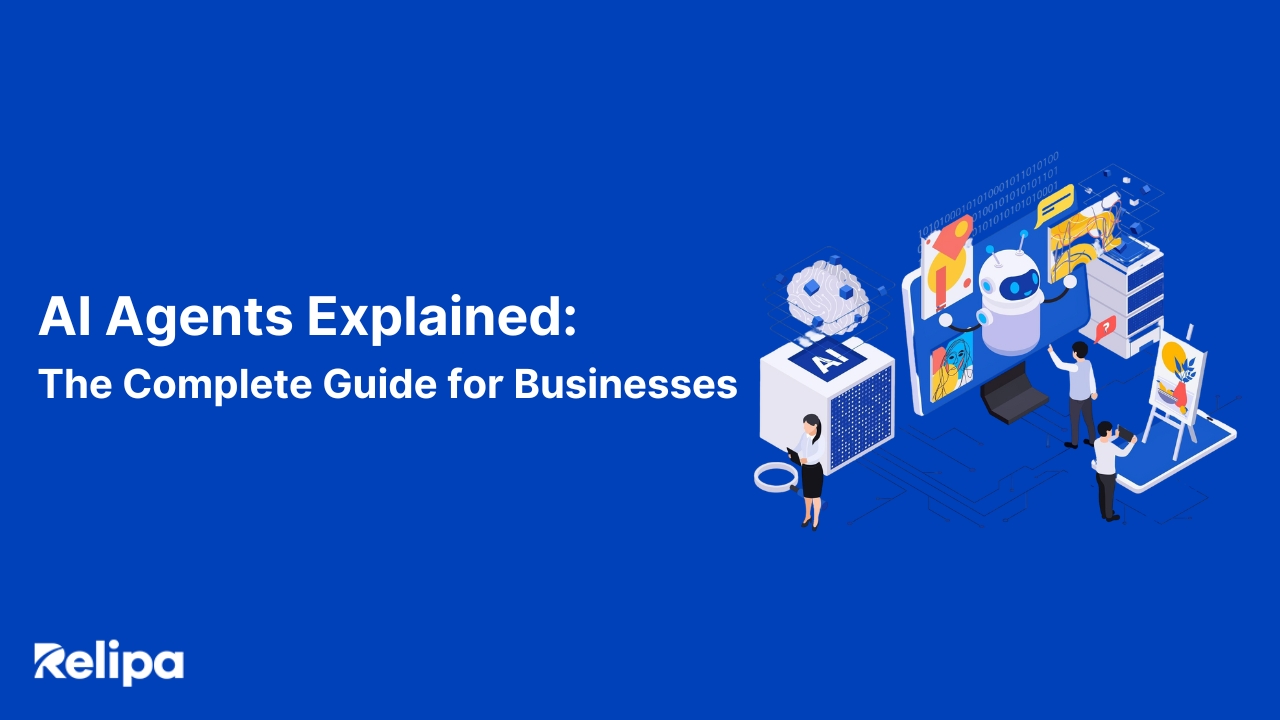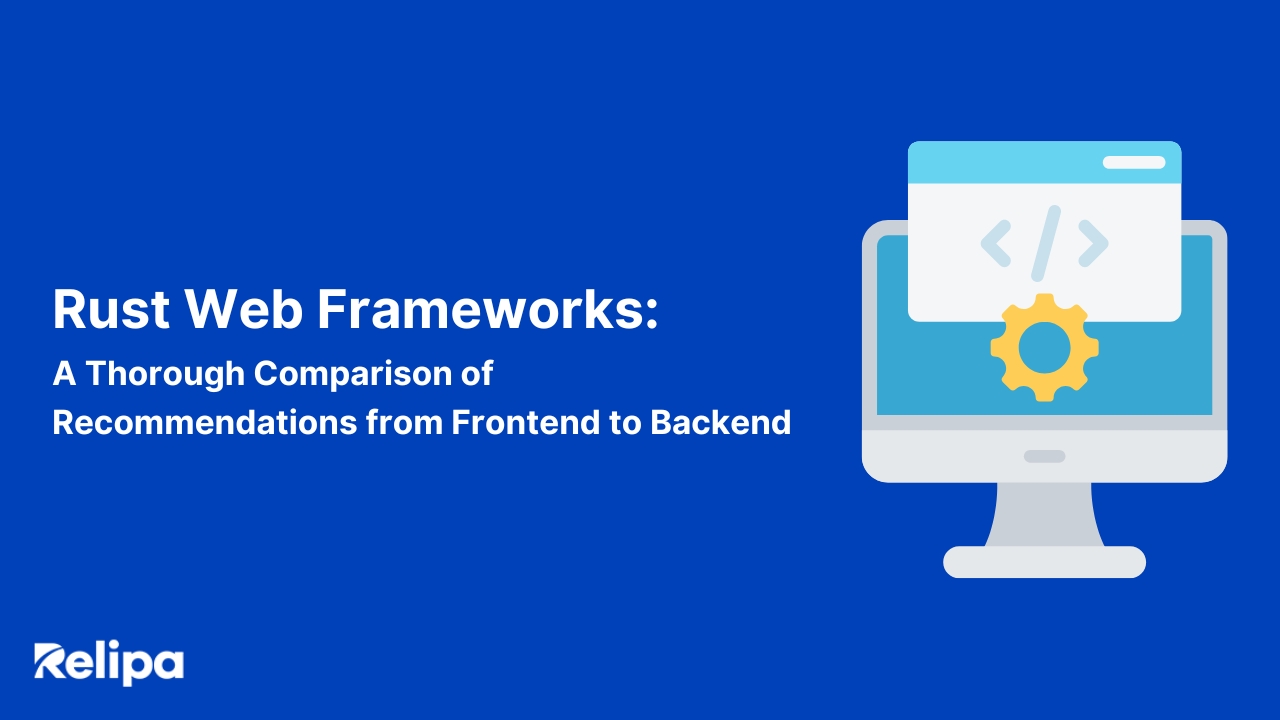10 Blockchain Myths and The Truth Behind Them
Blockchain is often portrayed as either the ultimate solution for everything or a pointless buzzword. Neither is true. The problem? A cloud of blockchain myths that oversimplify or misrepresent what the technology actually does.
Executives and decision-makers face an important challenge, separating blockchain’s real business value from the noise of exaggerated claims. Too many organizations make choices based on blockchain myths, rather than facts.
This blog breaks down the 10 most common blockchain myths that every leader should understand.
Myth 1: Blockchain = Bitcoin
This misconception makes sense at first glance: Bitcoin was the first large-scale application of blockchain, and it brought the technology into the public eye. For years, most media coverage treated the two as interchângble, cementing the idea that “blockchain = Bitcoin” in people’s minds.
Reality: Bitcoin is a digital currency that uses blockchain as its foundation. Blockchain itself is much broader, it is a form of distributed ledger technology (DLT) that records and verifies transactions across a network without relying on a central authority. This ledger can be public, like Bitcoin or Ethereum, or private and permissioned, such as those used by enterprises like IBM’s Hyperledger Fabric or R3’s Corda.
Beyond cryptocurrencies, blockchain is powering a wide range of real-world applications:
- Supply chain transparency: Walmart and IBM use blockchain to trace food origins in seconds instead of days, improving safety and recall efficiency
- Digital identity: Governments and startups are piloting blockchain-based ID systems to give citizens control over their personal data
- Healthcare record-keeping: Hospitals are exploring blockchain to securely share medical records across different providers
- Tokenization of assets: From real estate to fine art, blockchain enables fractional ownership and transparent transfer of traditionally illiquid assets
Think of it this way: Bitcoin is like email, while blockchain is like the entire internet. Email was one of the internet’s first killer applications, but the internet itself supports countless other services, websites, streaming, cloud computing, e-commerce, etc. Similarly, Bitcoin may have introduced blockchain to the world, but it’s only one application among many.
Myth 2: Blockchain is only for cryptocurrencies
When most people hear the word blockchain, the first thing that comes to mind is Bitcoin or some other cryptocurrency. It’s easy to see why, digital coins have dominated headlines for years. But this narrow view has created a dangerous blind spot: assuming that if you’re not in the crypto business, blockchain has nothing to offer.
This narrow view ignores the technology’s real strength, its ability to create a single, verifiable record that no single party controls. In practice, that means companies can cut out layers of manual reconciliation, reduce fraud, and build trust with partners or consumers without relying on a central authority.
- Retail: Helps trace products from origin to shelf, cutting response time in food recalls from days to seconds.
- Pharmaceuticals: Provides a defense against counterfeit drugs by certìying supply chains
- Energy: Enables households to trade excess power directly with their neighbors
Put simply, cryptocurrency is only the tip of the iceberg. The real power of blockchain emerges when industries apply it to everyday challenges that demand trust without intermediaries.
Myth 3: Blockchain is completely secure and immutable
The phrase “blockchain can’t be hacked” often circulates in media and marketing, giving the impression that the technology is a silver bullet for security. Because the core design of blockchain, decentralization, cryptographic hashing, and consensus algorithms, makes tampering with records extremely difficult. Blocks are linked together, and altering one requires changing every block after it across a majority of network nodes. This design is far stronger than traditional centralized databases, which explains why many assume it’s unbreakable.
But in reality, blockchain is resilient, not invincible. Attacks and vulnerabilities can still occur:
- Consensus attacks (51% attack): If a malicious actor controls the majority of mining or validation power, they can manipulate transactions. This has happened multiple times with smaller proof-of-work coins such as Ethereum Classic and Bitcoin Gold.
- Smart contract flaws: Code is law in blockchain systems, but poorly written contracts can be exploited. The most famous case is the DAO hack in 2016, where a vulnerability in the contract logic led to $60+ million worth of Ether being siphoned off.
- Off-chain weakness: Even if the blockchain itself is secure, supporting infrastructure like crypto exchanges, wallets, or bridges are common attack targets. The 2022 Ronin Bridge hack, where attackers stole over $600 million, had nothing to do with blockchain’s consensus layer but with weak security controls around private keys.
- Human error and governance: Lost private keys, misconfigured nodes, and lack of proper audits remain major risks that no technology can fully eliminate.
Blockchain offers strong security advantages compared to traditional systems, but treating it as “unhackable” is a mistake. Like any technology, it requires careful design, continuous monitoring, and robust governance.
Myth 4: Blockchain is too expensive to implement
Many businesses assume that only tech giants or well-funded startups can afford to explore blockchain, while smaller organizations are priced out before they even start. This belief often comes from early stories about Bitcoin mining consuming massive energy or enterprises spending millions on experimental pilots. Add to that the fear of needing entirely new infrastructure and specialized talent, and it’s no surprise some executives conclude that blockchain is financially unrealistic.
Implementing blockchain doesn’t have to break the bank. While certain applications (like running a public blockchain or large-scale mining) can be resource-intensive, most enterprise use cases run on permissioned networks that are far more cost-effective. These networks can be deployed on existing cloud infrastructure, and open-source platforms like Hyperledger Fabric, Corda, or Quorum significantly reduce licensing expenses.
Costs also depend on scale and complexity:
- Small pilots can be launched quickly to test business value before scaling.
- Cloud-based blockchain services from providers like AWS, Azure, or IBM Blockchain allow companies to pay-as-they-go rather than build everything from scratch.
- Efficiency gains (fewer intermediaries, faster settlement, better traceability) often outweigh initial costs, leading to long-term savings.
The perception that blockchain is “too expensive” is outdated. With modular platforms, cloud services, and scalable pilots, organizations of all sizes can explore blockchain technology without incurring massive upfront costs.
Myth 5: Blockchain is environmentally destructive
Media reports often highlight how Bitcoin mining consumes more electricity than entire countries, fueling the belief that blockchain and sustainability are fundamentally incompatible. This perception stems from the proof-of-work (PoW) consensus mechanism used by Bitcoin and some other cryptocurrencies. PoW requires miners to solve complex mathematical problems, a process that demands significant computational power and, by extension, energy consumption. Headlines comparing Bitcoin to Argentina or the Netherlands in energy use have cemented this image in the public’s mind
Not every blockchain relies on PoW, many modern networks use proof-of-stake (PoS) or other consensus models that consume a fraction of the energy. In fact, when Ethereum transitioned from PoW to PoS in 2022, it reduced its energy consumption by more than 99% overnight.
Additionally, energy use is one side of the story:
- Cleaner energy sources: A growing share of mining now uses renewable energy, particularly in regions with surplus hydro, wind, or solar power.
- Efficiency initiatives: Networks are constantly evolving, with Layer 2 solutions and carbon-offsetting projects helping reduce blockchain’s footprint.
- Beyond PoW: Enterprise and permissioned blockchains (used in supply chains, healthcare, and finance) are far less energy-intensive than public mining-based systems.
Blockchain does not automatically equal environmental harm. The outdated view of “all blockchains waste energy” ignores major advances in consensus mechanisms and sustainable practices. Like any technology, its impact depends on how it is designed and deployed. The new reality: blockchain can be part of the green transition rather than an obstacle to it.
Myth 6: Blockchain is completely anonymous
Many people believe that transactions on Bitcoin or other networks are invisible to governments, banks, or regulators, fueling the stereotype that blockchain is a safe heaven for criminals. In the early days of Bitcoin, platforms like Silk Road gave the impression that blockchain was a dark web tool that allowed people to transact “in secret”. Since users don’t need to provide names or personal details when creating a wallet, it seemed logical to assume that blockchain is untraceable anonymity.
Blockchain transactions are pseudonymous, not anonymous. Every transaction is permanently recorded on a public ledger, visible to anyone. Instead of real names, transactions are linked to wallet addresses. While these addresses don’t reveal identities by themselves, once linked to a real-world person (e.g., through an exchange or KYC process), all of their past and future transactions can be traced.
Law enforcement agencies and analytics firms now use blockchain’s transparency to track illegal activities:
- The FBI successfully shut down Silk Road by tracing Bitcoin transactions on the blockchain.
- Chainalysis and other analytics companies help governments and financial institutions monitor suspicious flows of funds.
- Stolen funds from high-profile hacks (like the Colonial Pipeline ransomware attack) have been partially recovered because the money trail was visible on-chain.
Blockchain does not guarantee invisibility. Instead, it creates an immutable, transparent trail that can actually make it easier to investigate suspicious activity compared to traditional cash. Users and businesses should understand that blockchain provides accountability, not a cloak of secrecy.
Myth 7: Blockchain eliminates the need for intermediaries
The idea of “cutting out the middle” has been a popular selling point in blockchain discussions, from financial services to supply chains. While it’s true that blockchain reduces reliance on certain intermediaries, the belief that it eliminates them altogether is misleading. Blockchain’s decentralized design allows participants to transact directly without a central authority verifying every step. In theory, this means no banks in payments, no notaries in contracts, and no brokers in asset exchanges.
Blockchain does not abolish intermediaries, it shapes who they are and what they do. Instead of removing all middle layers, it often replaces them with new roles or transforms existing ones:
- Technical intermediaries: Developers, miners, validators, or node operators are essential for maintaining networks.
- Governance intermediaries: Regulatory bodies, compliance officers, and consortium administrators still play a role in ensuring fairness and legal adherence.
- Practical intermediaries: Even in DeFi, users rely on wallets, exchanges, and custodial services that act as trusted interfaces.
Blockchain can reduce the costs and frictions created by unnecessary intermediaries, but it rarely eliminates them completely. Instead, it turns traditional gatekeepers into new types of facilitators.
Myth 8: Blockchain is too slow and can’t scale
Critics often point to Bitcoin processing just 7 transactions per second (TPS) or Ethereum’s congestion during NFT booms as proof that blockchain can never handle mainstream adoption. Early blockchains prioritized decentralization and security over speed. For example, Bitcoin’s design deliberately limits block size and time to preserve network stability. As a result, compared to Visa’s 24,000+ TPS capacity, blockchain’s early performance looked unimpressive.
Scalability challenges are real, but they are not permanent. Blockchain performance has advanced dramatically with new technologies:
- Layer 2 solutions like the Lightning Network (Bitcoin) and rollups (Ethereum) enable thousands of TPS while keeping costs low.
- New consensus models (Proof-of-Stake, Delegated Proof-of-Stake, Byzantine Fault Tolerance variants) allow much faster confirmation times without compromising security.
- High-throughput blockchains such as Solana, Avalanche, and Aptos claim capacities of tens of thousands of TPS, rivaling traditional payment systems.
- Hybrid models let enterprises combine blockchain’s transparency with off-chain data processing to achieve both speed and trust.
Early blockchains indeed struggled with speed and scalability, but today’s landscape is evolving rapidly. With Layer 2 innovations, next-gen consensus, and enterprise-focused solutions, blockchain is no longer stuck at “7 TPS.”
Myth 9: Every company should adopt blockchain immediately
With all the hype around blockchain, another myth has taken hold: that every organization, no matter its size or sector, must adopt blockchain right away or risk being left behind. The fear of “missing out” pushes some executives to pursue blockchain projects without a clear business case. Media headlines about banks, governments, or Fortune 500 companies experimenting with blockchain reinforce the idea that adoption is inevitable for everyone. This has created a bandwagon effect, where businesses feel pressured to jump in just to appear innovative.
Blockchain is not a universal solution. It is best suited for situations where:
- Multiple parties need to share and verify data.
- Trust between stakeholders is limited or costly to establish.
- Transparency, auditability, and tamper-resistance are critical.
Not every company needs blockchain today, and rushing into adoption without alignment to business goals is a recipe for wasted resources. Instead, organizations should start with the question: Does blockchain solve a real trust or transparency problem in my ecosystem? If the answer is yes, it’s worth exploring. If not, traditional solutions may be more practical.
Myth 10: Smart contracts are the same as legal contracts
The name itself often leads people to assume that a smart contract carries the same legal enforceability as an agreement drafted by lawyers and recognized by courts. Since smart contracts execute actions automatically when certain conditions are met, many assume they are both “smart” and “legally binding.” Media coverage of blockchain disrupting lawyers and notaries has further reinforced this misunderstanding.
But a smart contract is not a legal contract. It is simply a piece of code stored on the blockchain that automatically executes transactions when predefined rules are met. For example, a smart contract can be programmed to release payment once goods are delivered and confirmed on-chain.
Whether a smart contract is legally enforceable depends on:
- Jurisdiction: Some countries (like the U.S. state of Arizona or countries in the EU) are exploring frameworks for recognizing smart contracts, but laws differ widely.
- Intent & agreement: Legal enforceability requires that parties have the intent to form a binding agreement, which usually involves signatures, disclosures, and compliance with contract law.
- Human interpretation: Legal contracts often cover nuances, exceptions, or disputes that cannot be fully captured in code. Smart contracts cannot resolve ambiguity, they execute exactly what’s programmed, even if the result seems unfair.
Smart contracts are automation tools, not replacements for lawyers or courts. They bring efficiency, transparency, and reliability to certain processes, but for now, they complement legal contracts rather than replace them. Businesses should treat them as programmable infrastructure, not as ready-made legal instruments.
Conclusion
Here’s the thing about blockchain myths, they exist because the technology grew faster than our ability to understand it. Everyone rushed to label it: too risky, too slow, too revolutionary. The truth is less dramatic, but far more interesting.
If we drop the extremes, the hype, and the cynicism, what’s left is a system quietly shaping how we prove things, identity, ownership, and authenticity in a digital world that desperately needs proof.
Get in touch with Relipa for more insights about blockchain technology!





